Legal Issues in Business Law
VerifiedAdded on 2023/01/18
|6
|1754
|84
AI Summary
This document discusses various legal issues in business law, including contractual terms, enforceability of exclusion clauses, and promissory estoppel. It provides rules, applications, and conclusions for each issue. The subject is Business Law, and the document type is a study material.
Contribute Materials
Your contribution can guide someone’s learning journey. Share your
documents today.
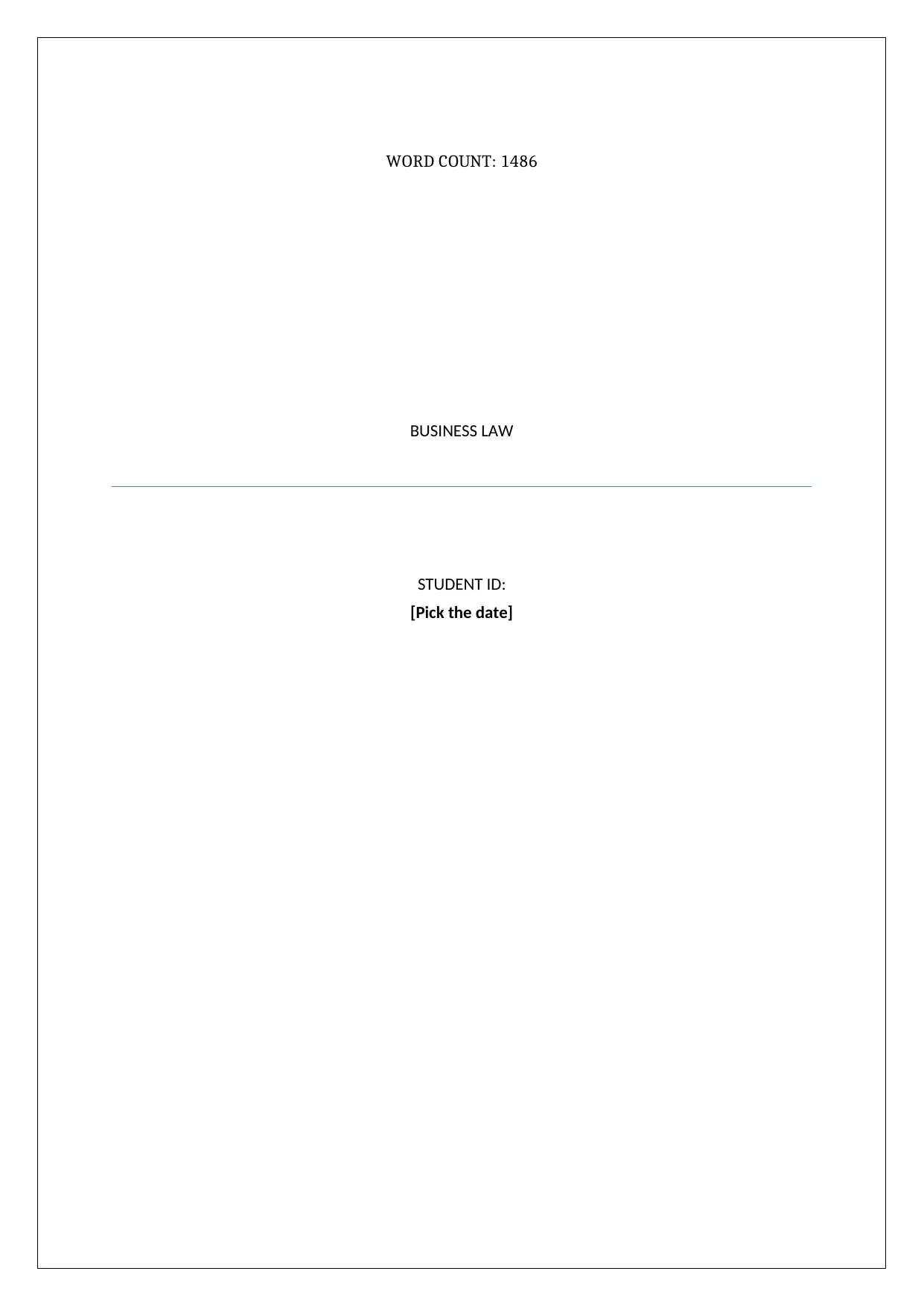
WORD COUNT: 1486
BUSINESS LAW
STUDENT ID:
[Pick the date]
BUSINESS LAW
STUDENT ID:
[Pick the date]
Secure Best Marks with AI Grader
Need help grading? Try our AI Grader for instant feedback on your assignments.

Question 1
Issue
The legal issue of significance is to determine if any of the statements made in the context of
MowMaster 3000 by Effah would be considered as contractual terms or not.
Rule
During the pre-contractual negotiation stage, a host of statements are made by the seller so as
to lure the buyer into entering contractual relations. Some of these may be facts while others
are opinions. The opinions expressed by the seller about the underlying product are
considered as puffery and hence lack legal validity as these are not part of the contract. On
the other hand, the factual statements about the product under sale are considered as
representations. However, not all representations are included in the contract as terms1.
To highlight the underlying conditions necessary to segregate mere representations from
terms,the relevant case law is Oscar Chess v Williams2. This case highlighted that only those
representations can be classified as terms which have a pivotal role in luring the buyer to
make the purchase. Further, there are some representations which are of non-essential nature
and these are categorised as warranty3.
Application
Considering the applicable rule discussed, critical legal analysis of Effah’s statements in the
context of mower can be carried out to determine if any statement is represented in the
contract. There are certain statements made by Effah which would be termed as puffery since
these were mere opinions that were expressed about the product and thereby not may be
valid. An example of mere representation in the context of MowMaster 3000 is that it is
made in Germany using best quality parts. This is not term as it is not an essential
representation for the contract. An apt example of the term from Effah’s statements would be
that blades would not get blunt and cut through anything. This representation is likely to be
pivotal for the decision to buy the mower on the part of Joan since she intended to use it for
cutting grass and the cutting ability of the mower is pivotal.
Conclusion
1 Robert Bryan Vermeesch and Kevin Edmund Lindgren, Business Law of Australia (Butterworths, 2013, 12th edition) 86
2 Oscar Chess v Williams [1957] 1 WLR 370
3 Athule Pathinayake, Commercial and Corporations Law, (Thomson-Reuters, 2014, 2nd edition) 98
2
Issue
The legal issue of significance is to determine if any of the statements made in the context of
MowMaster 3000 by Effah would be considered as contractual terms or not.
Rule
During the pre-contractual negotiation stage, a host of statements are made by the seller so as
to lure the buyer into entering contractual relations. Some of these may be facts while others
are opinions. The opinions expressed by the seller about the underlying product are
considered as puffery and hence lack legal validity as these are not part of the contract. On
the other hand, the factual statements about the product under sale are considered as
representations. However, not all representations are included in the contract as terms1.
To highlight the underlying conditions necessary to segregate mere representations from
terms,the relevant case law is Oscar Chess v Williams2. This case highlighted that only those
representations can be classified as terms which have a pivotal role in luring the buyer to
make the purchase. Further, there are some representations which are of non-essential nature
and these are categorised as warranty3.
Application
Considering the applicable rule discussed, critical legal analysis of Effah’s statements in the
context of mower can be carried out to determine if any statement is represented in the
contract. There are certain statements made by Effah which would be termed as puffery since
these were mere opinions that were expressed about the product and thereby not may be
valid. An example of mere representation in the context of MowMaster 3000 is that it is
made in Germany using best quality parts. This is not term as it is not an essential
representation for the contract. An apt example of the term from Effah’s statements would be
that blades would not get blunt and cut through anything. This representation is likely to be
pivotal for the decision to buy the mower on the part of Joan since she intended to use it for
cutting grass and the cutting ability of the mower is pivotal.
Conclusion
1 Robert Bryan Vermeesch and Kevin Edmund Lindgren, Business Law of Australia (Butterworths, 2013, 12th edition) 86
2 Oscar Chess v Williams [1957] 1 WLR 370
3 Athule Pathinayake, Commercial and Corporations Law, (Thomson-Reuters, 2014, 2nd edition) 98
2
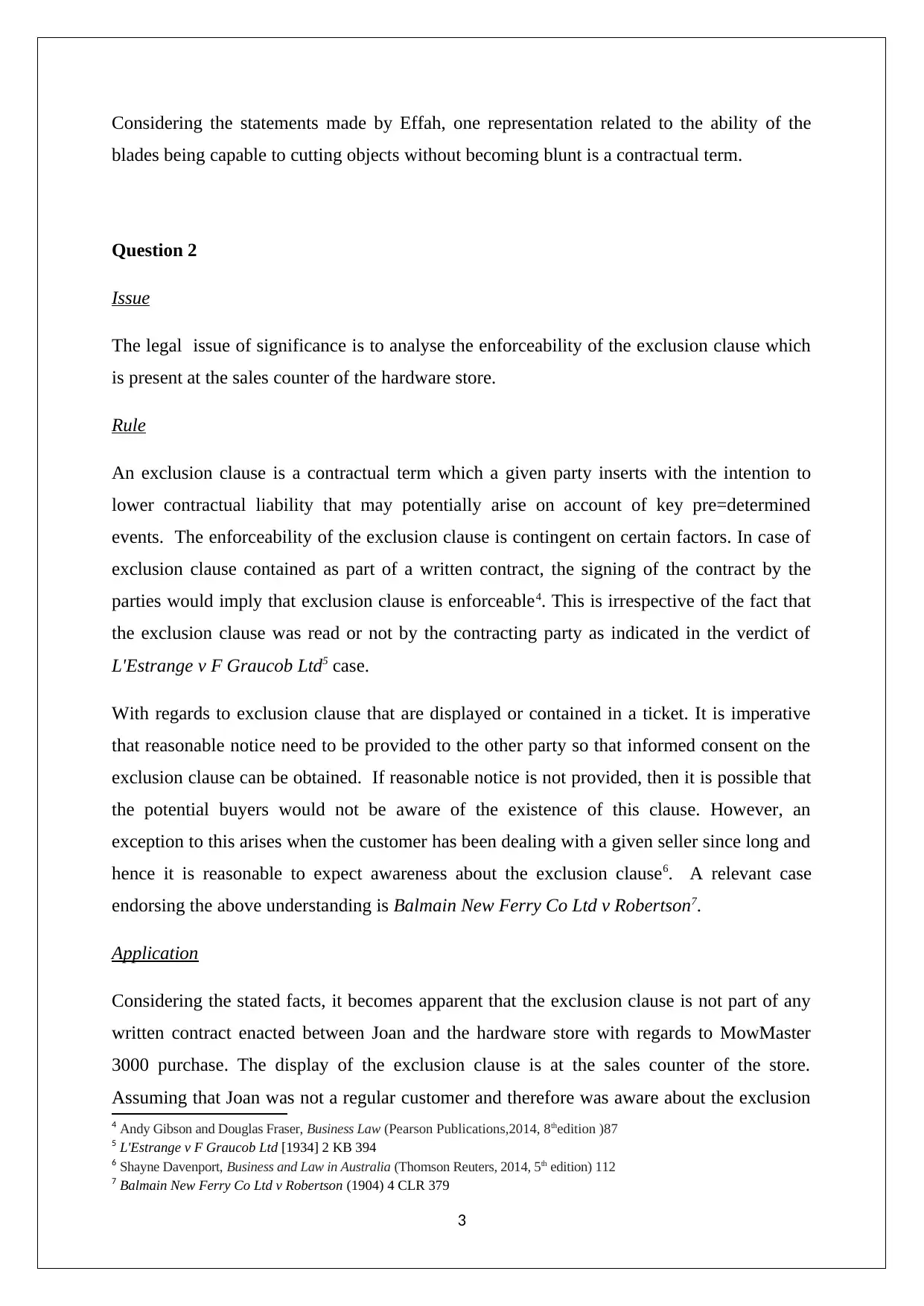
Considering the statements made by Effah, one representation related to the ability of the
blades being capable to cutting objects without becoming blunt is a contractual term.
Question 2
Issue
The legal issue of significance is to analyse the enforceability of the exclusion clause which
is present at the sales counter of the hardware store.
Rule
An exclusion clause is a contractual term which a given party inserts with the intention to
lower contractual liability that may potentially arise on account of key pre=determined
events. The enforceability of the exclusion clause is contingent on certain factors. In case of
exclusion clause contained as part of a written contract, the signing of the contract by the
parties would imply that exclusion clause is enforceable4. This is irrespective of the fact that
the exclusion clause was read or not by the contracting party as indicated in the verdict of
L'Estrange v F Graucob Ltd5 case.
With regards to exclusion clause that are displayed or contained in a ticket. It is imperative
that reasonable notice need to be provided to the other party so that informed consent on the
exclusion clause can be obtained. If reasonable notice is not provided, then it is possible that
the potential buyers would not be aware of the existence of this clause. However, an
exception to this arises when the customer has been dealing with a given seller since long and
hence it is reasonable to expect awareness about the exclusion clause6. A relevant case
endorsing the above understanding is Balmain New Ferry Co Ltd v Robertson7.
Application
Considering the stated facts, it becomes apparent that the exclusion clause is not part of any
written contract enacted between Joan and the hardware store with regards to MowMaster
3000 purchase. The display of the exclusion clause is at the sales counter of the store.
Assuming that Joan was not a regular customer and therefore was aware about the exclusion
4 Andy Gibson and Douglas Fraser, Business Law (Pearson Publications,2014, 8thedition )87
5 L'Estrange v F Graucob Ltd [1934] 2 KB 394
6 Shayne Davenport, Business and Law in Australia (Thomson Reuters, 2014, 5th edition) 112
7 Balmain New Ferry Co Ltd v Robertson (1904) 4 CLR 379
3
blades being capable to cutting objects without becoming blunt is a contractual term.
Question 2
Issue
The legal issue of significance is to analyse the enforceability of the exclusion clause which
is present at the sales counter of the hardware store.
Rule
An exclusion clause is a contractual term which a given party inserts with the intention to
lower contractual liability that may potentially arise on account of key pre=determined
events. The enforceability of the exclusion clause is contingent on certain factors. In case of
exclusion clause contained as part of a written contract, the signing of the contract by the
parties would imply that exclusion clause is enforceable4. This is irrespective of the fact that
the exclusion clause was read or not by the contracting party as indicated in the verdict of
L'Estrange v F Graucob Ltd5 case.
With regards to exclusion clause that are displayed or contained in a ticket. It is imperative
that reasonable notice need to be provided to the other party so that informed consent on the
exclusion clause can be obtained. If reasonable notice is not provided, then it is possible that
the potential buyers would not be aware of the existence of this clause. However, an
exception to this arises when the customer has been dealing with a given seller since long and
hence it is reasonable to expect awareness about the exclusion clause6. A relevant case
endorsing the above understanding is Balmain New Ferry Co Ltd v Robertson7.
Application
Considering the stated facts, it becomes apparent that the exclusion clause is not part of any
written contract enacted between Joan and the hardware store with regards to MowMaster
3000 purchase. The display of the exclusion clause is at the sales counter of the store.
Assuming that Joan was not a regular customer and therefore was aware about the exclusion
4 Andy Gibson and Douglas Fraser, Business Law (Pearson Publications,2014, 8thedition )87
5 L'Estrange v F Graucob Ltd [1934] 2 KB 394
6 Shayne Davenport, Business and Law in Australia (Thomson Reuters, 2014, 5th edition) 112
7 Balmain New Ferry Co Ltd v Robertson (1904) 4 CLR 379
3
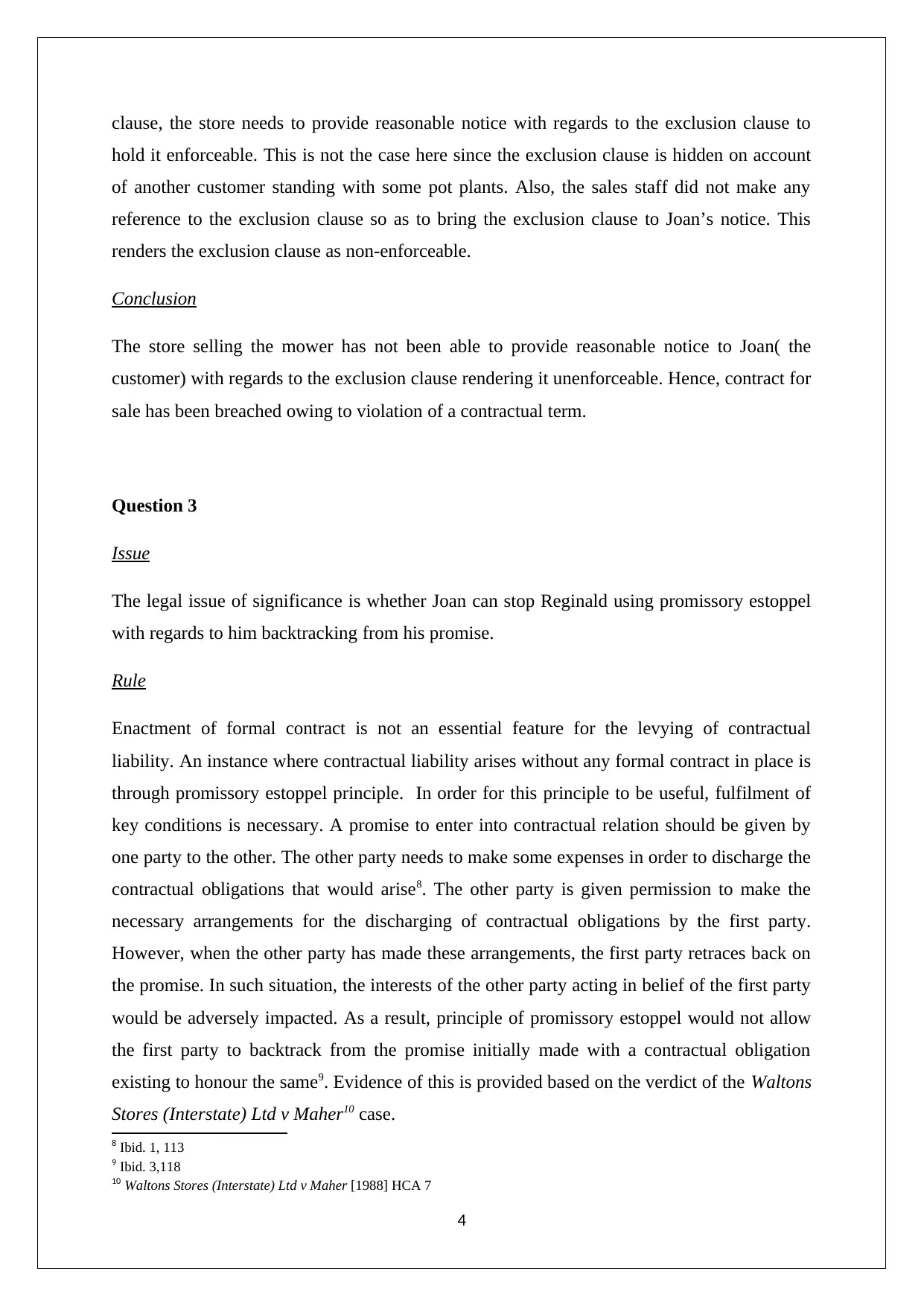
clause, the store needs to provide reasonable notice with regards to the exclusion clause to
hold it enforceable. This is not the case here since the exclusion clause is hidden on account
of another customer standing with some pot plants. Also, the sales staff did not make any
reference to the exclusion clause so as to bring the exclusion clause to Joan’s notice. This
renders the exclusion clause as non-enforceable.
Conclusion
The store selling the mower has not been able to provide reasonable notice to Joan( the
customer) with regards to the exclusion clause rendering it unenforceable. Hence, contract for
sale has been breached owing to violation of a contractual term.
Question 3
Issue
The legal issue of significance is whether Joan can stop Reginald using promissory estoppel
with regards to him backtracking from his promise.
Rule
Enactment of formal contract is not an essential feature for the levying of contractual
liability. An instance where contractual liability arises without any formal contract in place is
through promissory estoppel principle. In order for this principle to be useful, fulfilment of
key conditions is necessary. A promise to enter into contractual relation should be given by
one party to the other. The other party needs to make some expenses in order to discharge the
contractual obligations that would arise8. The other party is given permission to make the
necessary arrangements for the discharging of contractual obligations by the first party.
However, when the other party has made these arrangements, the first party retraces back on
the promise. In such situation, the interests of the other party acting in belief of the first party
would be adversely impacted. As a result, principle of promissory estoppel would not allow
the first party to backtrack from the promise initially made with a contractual obligation
existing to honour the same9. Evidence of this is provided based on the verdict of the Waltons
Stores (Interstate) Ltd v Maher10 case.
8 Ibid. 1, 113
9 Ibid. 3,118
10 Waltons Stores (Interstate) Ltd v Maher [1988] HCA 7
4
hold it enforceable. This is not the case here since the exclusion clause is hidden on account
of another customer standing with some pot plants. Also, the sales staff did not make any
reference to the exclusion clause so as to bring the exclusion clause to Joan’s notice. This
renders the exclusion clause as non-enforceable.
Conclusion
The store selling the mower has not been able to provide reasonable notice to Joan( the
customer) with regards to the exclusion clause rendering it unenforceable. Hence, contract for
sale has been breached owing to violation of a contractual term.
Question 3
Issue
The legal issue of significance is whether Joan can stop Reginald using promissory estoppel
with regards to him backtracking from his promise.
Rule
Enactment of formal contract is not an essential feature for the levying of contractual
liability. An instance where contractual liability arises without any formal contract in place is
through promissory estoppel principle. In order for this principle to be useful, fulfilment of
key conditions is necessary. A promise to enter into contractual relation should be given by
one party to the other. The other party needs to make some expenses in order to discharge the
contractual obligations that would arise8. The other party is given permission to make the
necessary arrangements for the discharging of contractual obligations by the first party.
However, when the other party has made these arrangements, the first party retraces back on
the promise. In such situation, the interests of the other party acting in belief of the first party
would be adversely impacted. As a result, principle of promissory estoppel would not allow
the first party to backtrack from the promise initially made with a contractual obligation
existing to honour the same9. Evidence of this is provided based on the verdict of the Waltons
Stores (Interstate) Ltd v Maher10 case.
8 Ibid. 1, 113
9 Ibid. 3,118
10 Waltons Stores (Interstate) Ltd v Maher [1988] HCA 7
4
Secure Best Marks with AI Grader
Need help grading? Try our AI Grader for instant feedback on your assignments.
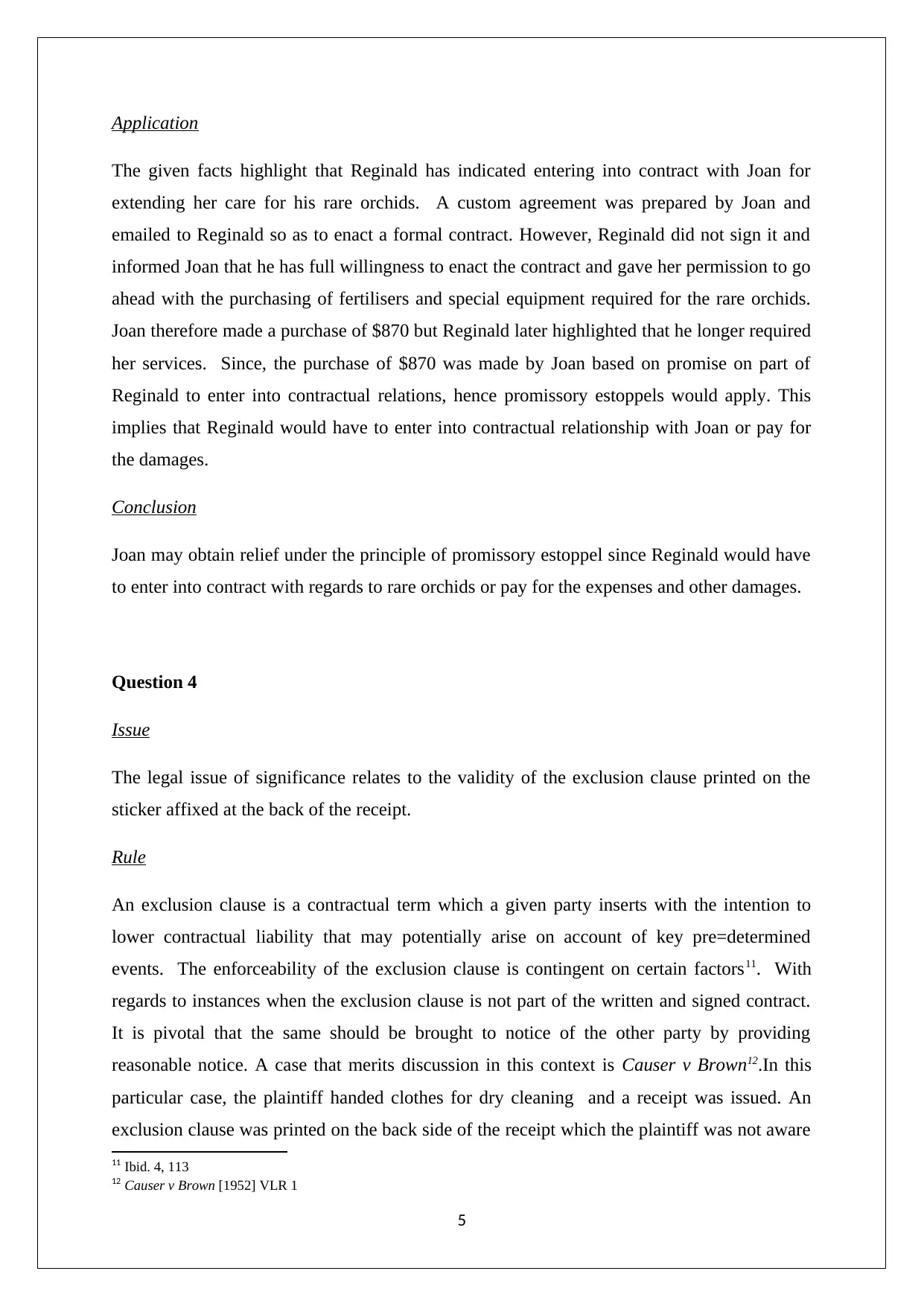
Application
The given facts highlight that Reginald has indicated entering into contract with Joan for
extending her care for his rare orchids. A custom agreement was prepared by Joan and
emailed to Reginald so as to enact a formal contract. However, Reginald did not sign it and
informed Joan that he has full willingness to enact the contract and gave her permission to go
ahead with the purchasing of fertilisers and special equipment required for the rare orchids.
Joan therefore made a purchase of $870 but Reginald later highlighted that he longer required
her services. Since, the purchase of $870 was made by Joan based on promise on part of
Reginald to enter into contractual relations, hence promissory estoppels would apply. This
implies that Reginald would have to enter into contractual relationship with Joan or pay for
the damages.
Conclusion
Joan may obtain relief under the principle of promissory estoppel since Reginald would have
to enter into contract with regards to rare orchids or pay for the expenses and other damages.
Question 4
Issue
The legal issue of significance relates to the validity of the exclusion clause printed on the
sticker affixed at the back of the receipt.
Rule
An exclusion clause is a contractual term which a given party inserts with the intention to
lower contractual liability that may potentially arise on account of key pre=determined
events. The enforceability of the exclusion clause is contingent on certain factors11. With
regards to instances when the exclusion clause is not part of the written and signed contract.
It is pivotal that the same should be brought to notice of the other party by providing
reasonable notice. A case that merits discussion in this context is Causer v Brown12.In this
particular case, the plaintiff handed clothes for dry cleaning and a receipt was issued. An
exclusion clause was printed on the back side of the receipt which the plaintiff was not aware
11 Ibid. 4, 113
12 Causer v Brown [1952] VLR 1
5
The given facts highlight that Reginald has indicated entering into contract with Joan for
extending her care for his rare orchids. A custom agreement was prepared by Joan and
emailed to Reginald so as to enact a formal contract. However, Reginald did not sign it and
informed Joan that he has full willingness to enact the contract and gave her permission to go
ahead with the purchasing of fertilisers and special equipment required for the rare orchids.
Joan therefore made a purchase of $870 but Reginald later highlighted that he longer required
her services. Since, the purchase of $870 was made by Joan based on promise on part of
Reginald to enter into contractual relations, hence promissory estoppels would apply. This
implies that Reginald would have to enter into contractual relationship with Joan or pay for
the damages.
Conclusion
Joan may obtain relief under the principle of promissory estoppel since Reginald would have
to enter into contract with regards to rare orchids or pay for the expenses and other damages.
Question 4
Issue
The legal issue of significance relates to the validity of the exclusion clause printed on the
sticker affixed at the back of the receipt.
Rule
An exclusion clause is a contractual term which a given party inserts with the intention to
lower contractual liability that may potentially arise on account of key pre=determined
events. The enforceability of the exclusion clause is contingent on certain factors11. With
regards to instances when the exclusion clause is not part of the written and signed contract.
It is pivotal that the same should be brought to notice of the other party by providing
reasonable notice. A case that merits discussion in this context is Causer v Brown12.In this
particular case, the plaintiff handed clothes for dry cleaning and a receipt was issued. An
exclusion clause was printed on the back side of the receipt which the plaintiff was not aware
11 Ibid. 4, 113
12 Causer v Brown [1952] VLR 1
5
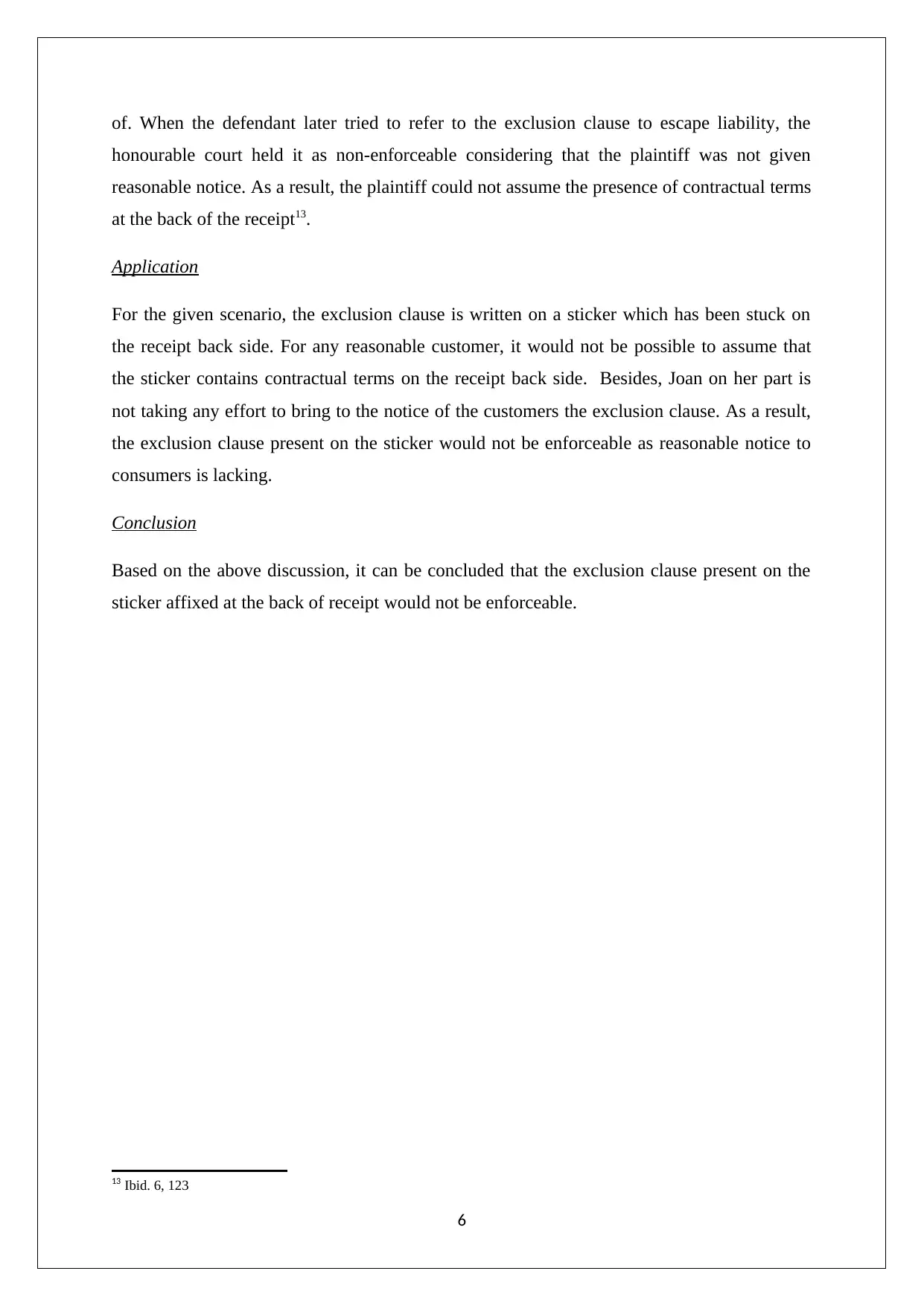
of. When the defendant later tried to refer to the exclusion clause to escape liability, the
honourable court held it as non-enforceable considering that the plaintiff was not given
reasonable notice. As a result, the plaintiff could not assume the presence of contractual terms
at the back of the receipt13.
Application
For the given scenario, the exclusion clause is written on a sticker which has been stuck on
the receipt back side. For any reasonable customer, it would not be possible to assume that
the sticker contains contractual terms on the receipt back side. Besides, Joan on her part is
not taking any effort to bring to the notice of the customers the exclusion clause. As a result,
the exclusion clause present on the sticker would not be enforceable as reasonable notice to
consumers is lacking.
Conclusion
Based on the above discussion, it can be concluded that the exclusion clause present on the
sticker affixed at the back of receipt would not be enforceable.
13 Ibid. 6, 123
6
honourable court held it as non-enforceable considering that the plaintiff was not given
reasonable notice. As a result, the plaintiff could not assume the presence of contractual terms
at the back of the receipt13.
Application
For the given scenario, the exclusion clause is written on a sticker which has been stuck on
the receipt back side. For any reasonable customer, it would not be possible to assume that
the sticker contains contractual terms on the receipt back side. Besides, Joan on her part is
not taking any effort to bring to the notice of the customers the exclusion clause. As a result,
the exclusion clause present on the sticker would not be enforceable as reasonable notice to
consumers is lacking.
Conclusion
Based on the above discussion, it can be concluded that the exclusion clause present on the
sticker affixed at the back of receipt would not be enforceable.
13 Ibid. 6, 123
6
1 out of 6
Related Documents
Your All-in-One AI-Powered Toolkit for Academic Success.
+13062052269
info@desklib.com
Available 24*7 on WhatsApp / Email
![[object Object]](/_next/static/media/star-bottom.7253800d.svg)
Unlock your academic potential
© 2024 | Zucol Services PVT LTD | All rights reserved.

![LAW. [Date]. Question 1. Issue. The main issue is to de](/_next/image/?url=https%3A%2F%2Fdesklib.com%2Fmedia%2Fimages%2Fbp%2F21fe1e6ab8ee47e1b904ddfd70315544.jpg&w=256&q=75)



